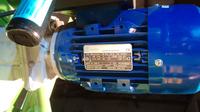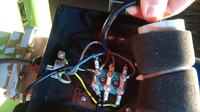At the beginning, I apologize for the topic because it was already like that, but it is closed.
Well, I have a problem and it is possible that they were created in the equipment buying phase.
I have a Liteon evo 600 1x230AC inverter that outputs ordinary U, V, W 230 V at the output
I have an engine
After connecting the motor to the 230 network everything is fine, I thought that I could connect to the two outputs of the inverter and the slime in the same way, but the engine starts, when starting up to 30Hz, it somehow turns above, the inverter throws an error and stops, man thought that there is a shift in phases and the engine will not work like that?
Is there an option to fasten it with this hardware configuration?
I connected in a triangle, but the inverter made an error that the motor was damaged and functional
Connection to the engine:

Well, I have a problem and it is possible that they were created in the equipment buying phase.
I have a Liteon evo 600 1x230AC inverter that outputs ordinary U, V, W 230 V at the output
I have an engine

After connecting the motor to the 230 network everything is fine, I thought that I could connect to the two outputs of the inverter and the slime in the same way, but the engine starts, when starting up to 30Hz, it somehow turns above, the inverter throws an error and stops, man thought that there is a shift in phases and the engine will not work like that?
Is there an option to fasten it with this hardware configuration?
I connected in a triangle, but the inverter made an error that the motor was damaged and functional
Connection to the engine:



